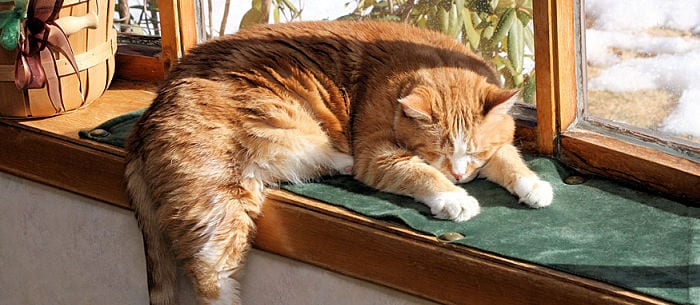Are you worried that your indoor cat may yearn for a life outside? You’re not alone. In fact, many cat owners wonder if their indoor cats are happy. But the truth of the matter is there are many ways that indoor cats are just as happy, or perhaps even happier, than their comrades who go out into the great outdoors. Here’s an overview of this great debate, as well as some tips on how you can keep your indoor cat as happy and healthy as can be.
Is Your Indoor Cat Happy?
Cats that are kept inside have limited exposure to parasites, diseases and poisons. This can extend their lifespan and reduce your vet bill! And these lowered risk factors also mean that your furry friend is less likely to experience chronic pain.
Your indoor cat also does not have to deal with the anxiety that comes with potentially dangerous encounters with cars, people and other animals. By keeping your cat safe and sound indoors, you can reduce the likelihood that she will get into a fight or get injured. Overall, indoor cats live in a much more stress-free environment than those that spend time outside.
But some may argue that a cat needs more stimulation in order to live a happy life. For instance, some indoor cats might not have enough room to roam, climb and explore. This may lead your cat to become accustomed to a sedentary life in which he is not actively engaged on a regular basis. And if your cat does not get enough exercise, he may become overweight or obese. Indoor cats might also develop some behavioral issues.
For example, your cat might start scratching or become overly clingy. Furthermore, due to the fact that indoor cats are not exposed to certain noises and stimuli, they might become overwhelmed and scared during trips to the vet or other outings.
How Can You Keep Your Indoor Cat Entertained and Engaged?
You might worry that your indoor cat is bored, especially if you leave her home alone during the day. “It is true that our human homes, with no alterations to provide some basic needs of your cat, makes for a boring space for most cats,” says Billie Reynolds, a cat behavior specialist and certified trainer who is a member of the International Association of Animal Behavior Consultants (IAABC). As your house might offer limited space to explore, it’s totally natural for you to think about whether or not your pet is getting enough stimulation.
But, with a little work, your home can provide a safe space for exciting mental enrichment! According to Reynolds, all you need to do is find a way to emulate the fun parts of being outside in a way that works indoors.
For instance, she recommends that you “put wildlife feeders up near the windows of your home. This will give your cat a natural prey to watch, hear and possibly smell (if you are able to open windows).” She also suggests that you leave toys and treats hidden around your house when you’re away. Your cat will love finding these little treasures! According to Reynolds, you should rotate these toys on a weekly basis to keep your pet interested.
How Can Your Ensure That Your Indoor Cat Gets Enough Exercise?
Cats love to climb and scratch, and one thing your home might be missing is an acceptable area for your pet to engage in these behaviors. In an effort to ensure that you cat stays active and maintains a healthy weight, you should provide her with “vertical territory, scratchers, beds and toys,” says Marilyn Krieger, also known as The Cat Coach, who is a certified cat behavior consultant.
This vertical territory could be made up of cat trees or shelves — any place that can serve as your pet’s own personal jungle gym! If you have more than one cat, Krieger urges you to make sure that you have enough resources available for each one, so that you “don’t have too many cats in too small of an area.” By doing so, you can ensure that your pets have plenty of room to climb, scratch, jump and play while indoors.
To further ensure that your cat is engaged on a daily basis, Reynolds suggests that you create a designated routine play time with her. She urges you to use interactive, wand-style toys that feature a natural prey item, such as a bird, bug or mouse. But another fun way to engage your cat is to have her chase a laser pointer! Your cat will really appreciate that you schedule this daily time to play, as these animals “love routine and consistency,” says Reynolds.
What Else Can You Do to Keep Your Indoor Cat Happy?
If your housing plan allows for it, try providing your cat with a perch on a window. This will allow your cat to soak up some sun while staying safely inside. You can also give your pet a taste of the great outdoors by installing a pot of cat grass just for her.
In an effort to keep your cat feeling engaged, you should have her interact with as many people as possible. If your cat is comfortable meeting new people, be sure to introduce her to any company that you have over to the house. And she’d just love to have a furry fried to play with! But, while adding another pet to the mix might keep your cat busy and entertained, you should consider the decision carefully. In an effort to prevent fighting, you should “introduce new cats to each other gradually,” warns Krieger.
And don’t forget the catnip! Providing your cat with toys stuffed with dry catnip is a great way to keep her happy. Check out Why You Should Get Catnip For Your Cat.
Kit Arbuckle works as a freelance writer covering parenting, education, health and pet care topics.





